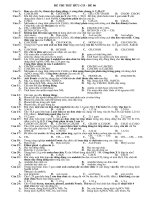Đề thi thử IELTS writing có câu trả lời
Bạn đang xem bản rút gọn của tài liệu. Xem và tải ngay bản đầy đủ của tài liệu tại đây (83.11 KB, 3 trang )
TEST 1
WRITING TASK 1
●
The graph below shows the contribution of three sectors-agriculture,
manufacturing, and business and financial services-to the UK economy in
the twentieth century.
Summarize the information by selecting and reporting the main features, and make
comparisons where relevant.
The bar graph compares the input from three sectors into British economy in the
twentieth century.
At the first glance, it is evident that the contributions made by agriculture and
manufacturing sides were tremendous in the earlier half of the century;
however, as the years progressed business and finance became the predominant
pillar of the British economy.
In the year 1900, the most significant contribution of approximately 50% was
made by agriculture department, this was succeeded by manufacturing sector
which had an input of around 45%. While, business and finance had a share of
mere 3%. After fifty years, the support to economy from agriculture segment
grew to around 53%, whereas, that from manufacturing department fell to about
37%. However, share by the business and finance mounted about two folds to
8%.
In the later part of the century, that is in the year 1975, the input from
agriculture side dropped dramatically to 10%. Same was the case with
manufacturing which saw a decline of 4%, albeit not as significant as
agriculture sector. Nevertheless, business and finance was the only segment
where improvement was noticed. At the end of the 20th century, agriculture
sector had an input of only about 3%, while, that from manufacturing it was
approximately 15%. The only area that continued to grow was business and
finance which finally had a contribution of about 35%.
WRITING TASK 2
You should spend about 20 minutes on this task.
Write about the following topic:
In the past lectures were the traditional method of teaching large numbers of
students. Nowadays new technology is increasingly being used to teach students.
What are the advantages and disadvantages of this new approach?
As we move into the twenty-first century, technology is affecting many
different areas of life and education is no exception. Indeed, in some institutions
traditional forms of education have been revolutionized by new technology to
the extent that the lecture is no longer the main method of delivery. While there
are a variety of benefits to this new approach, there are also
significant drawbacks.
Perhaps the greatest bonus of the introduction of technology is
the flexibility it offers. This is evident in two different ways. Firstly, it is now no
longer essential for students to be present in the lecture theatre for their courses.
This means that part-time courses for adults who are in employment
and distance learning courses for people in other countries are now much more
practical. Another area of flexibility is of course that the lecturer and tutor are
able to use Moodles, interactive whiteboards and other tools to deliver their
courses in a more stimulating way to large numbers of students.
Not everything, however, about the introduction of this new technology
into education is positive. One major problem is that not all students are
comfortable with using technology, even if they are part of the digital native
generation. This is a serious issue as they may suffer from their lack
of technological skills. Another related issue is that education is a human
activity and it works best with as much human interaction as possible.
Impersonal technology cannot replace the human contact found in traditional
face-to-face tutorials and seminars.
As we have seen, there are major benefits to the introduction of
technology into education, not least because it enables modern forms of
education such as distance learning courses. This is balanced, however, by the
fact that it can be too impersonal for some and disadvantages others for their
lack of technological skills.









